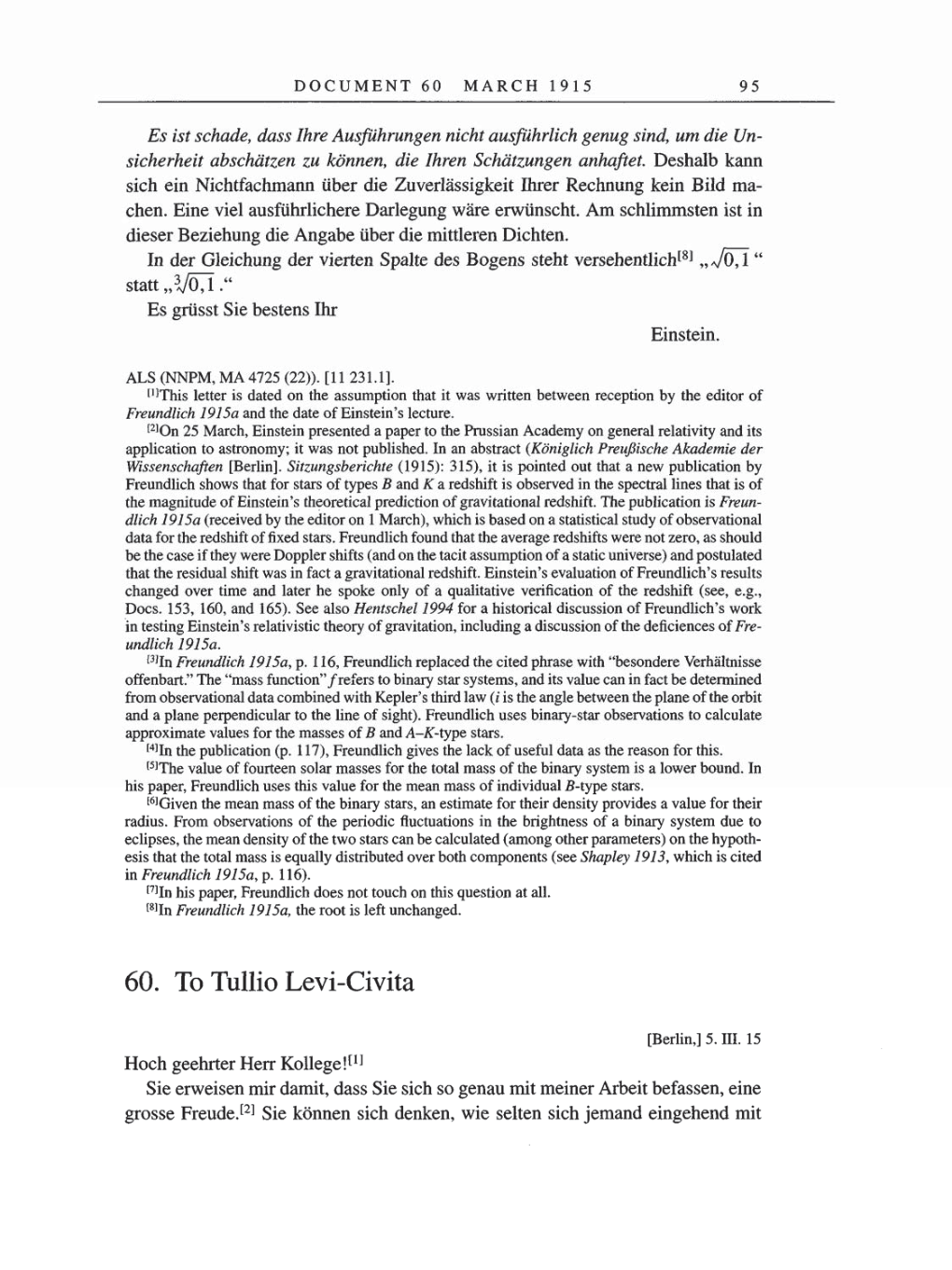DOCUMENT
60 MARCH
1915
95
Es ist
schade,
dass Ihre
Ausführungen
nicht
ausführlich
genug
sind,
um
die
Un-
sicherheit
abschätzen
zu
können,
die Ihren
Schätzungen anhaftet.
Deshalb
kann
sich ein Nichtfachmann
über
die
Zuverlässigkeit
Ihrer
Rechnung
kein Bild
ma-
chen.
Eine viel ausführlichere
Darlegung
wäre erwünscht. Am schlimmsten ist in
dieser
Beziehung
die
Angabe
über
die mittleren Dichten.
In
der
Gleichung
der
vierten
Spalte
des
Bogens
steht versehentlich[8] "v/0,1"
statt
"3v/0,1J."
Es
grüsst
Sie bestens
Ihr
Einstein.
ALS
(NNPM,
MA 4725
(22)).
[11
231.1].
[1]This
letter is dated
on
the
assumption
that
it
was
written between
reception by
the
editor of
Freundlich 1915a and the date
of
Einstein’s lecture.
[2]On
25
March,
Einstein presented
a paper
to the Prussian
Academy on
general
relativity
and its
application
to
astronomy;
it
was
not
published.
In
an
abstract
(Königlich
Preußische Akademie
der
Wissenschaften
[Berlin].
Sitzungsberichte
(1915): 315),
it
is
pointed
out that
a
new publication
by
Freundlich
shows that
for
stars
of
types
B and K
a
redshift
is observed in the
spectral
lines that is
of
the
magnitude
of
Einstein’s theoretical
prediction
of
gravitational
redshift. The
publication
is Freun-
dlich
1915a
(received by
the
editor
on
1
March),
which is
based
on a
statistical
study
of
observational
data
for the redshift
of
fixed stars. Freundlich found that the
average
redshifts
were
not
zero,
as
should
be
the
case
if
they were
Doppler
shifts
(and
on
the tacit
assumption
of
a
static
universe)
and
postulated
that
the residual shift
was
in fact
a gravitational
redshift. Einstein’s evaluation
of
Freundlich’s results
changed
over
time and
later he
spoke only
of
a qualitative
verification
of
the
redshift
(see, e.g.,
Docs. 153, 160, and
165).
See
also Hentschel
1994
for
a
historical
discussion
of
Freundlich’s work
in
testing
Einstein’s
relativistic theory
of
gravitation,
including
a
discussion
of
the deficiences
of
Fre-
undlich 1915a.
[3]In
Freundlich
1915a, p. 116,
Freundlich
replaced
the cited
phrase
with “besondere Verhältnisse
offenbart.” The "mass
function"
frefers
to
binary
star systems,
and its value
can
in
fact
be
determined
from
observational data
combined
with
Kepler’s
third law
(i
is the
angle
between the
plane
of
the orbit
and
a plane perpendicular
to
the
line
of
sight).
Freundlich
uses
binary-star
observations
to
calculate
approximate
values
for
the
masses
of
B
and
A-K-type
stars.
[4]In
the
publication (p.
117),
Freundlich
gives
the
lack of
useful data
as
the
reason
for
this.
[5]The
value
of
fourteen solar
masses
for
the total
mass
of
the
binary system
is
a
lower bound. In
his
paper,
Freundlich
uses
this value for the
mean mass
of
individual
B-type
stars.
[6]Given
the
mean
mass
of
the
binary
stars,
an
estimate
for their
density provides a
value
for their
radius. From observations
of
the
periodic
fluctuations in the
brightness
of
a binary system
due to
eclipses,
the
mean density
of
the two
stars
can
be calculated
(among
other
parameters) on
the
hypoth-
esis that the total
mass
is
equally
distributed
over
both
components
(see
Shapley
1913,
which
is
cited
in Freundlich
1915a,
p. 116).
[7]In
his
paper,
Freundlich does not touch
on
this
question
at all.
[8]In
Freundlich
1915a,
the
root
is
left
unchanged.
60. To
Tullio Levi-Civita
[Berlin,]
5.
III. 15
Hoch
geehrter
Herr
Kollege![1]
Sie erweisen mir
damit,
dass Sie sich
so genau
mit meiner Arbeit
befassen,
eine
grosse
Freude.[2]
Sie
können
sich
denken,
wie selten sich
jemand eingehend
mit
